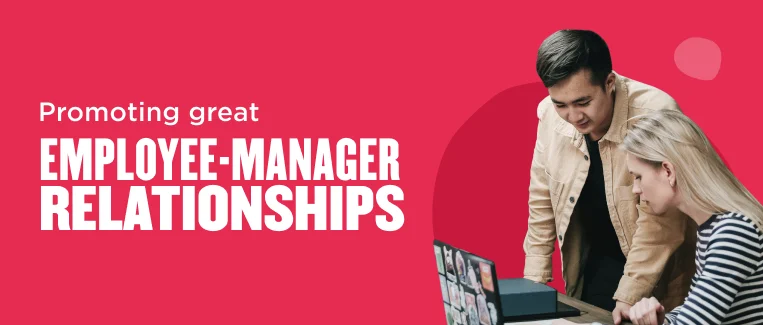Checking in and regularly receiving feedback can make or break company growth. As people leaders, it’s necessary to bridge the gap between professional development and the milestones that shape people’s lives. Approaching your employees’ needs, personal preferences, or life changes can seem intimidating.
One of the best ways to help people succeed professionally (and in life) is to nurture a culture of trust at work. Lifecycle feedback programs are a great place to start.
Cultures of trust begin with listening
The new world of work requires a new relationship between managers and employees, and the most important element is trust. But how do you build it? When people feel heard, it builds camaraderie, trust, and loyalty. It also reduces stress. Getting feedback from your people is key.
Effective feedback architectures should make it easy to gather feedback from team members at various stages of their employee lifecycle. Feedback should serve as a routine and stress-free way to check in with people regarding their experiences in training, career progression, and more over time.
The foundation of healthy company cultures
If we don’t engage with our people and check in regularly, there’s a good chance they’ll start to feel detached and unmotivated and start exploring other opportunities. It’s essential to build relationships built on trust to avoid attrition.
Encouraging routine, open conversations takes the pressure off people when they meet with managers and HR leaders. Regular conversations also help organizations identify what actions to take at each stage of a person’s career and which actions will positively impact metrics like engagement, attrition, and productivity.
Promoting great employee-manager relationships with Employee Lifecycle Feedback
Bob’s Employee Lifecycle Feedback tool helps HR leaders and managers engage their teams regularly with a 360-degree approach and build robust feedback architectures that support cultures of trust. The tool provides surveys designed to collect information in real time that provide insights into your teams’ professional progress. Milestone tracking at every stage of the employee lifecycle also helps contextualize the data and helps people feel that they’re heard and valued, improving employee satisfaction.
The adaptability of Employee Lifecycle Feedback also allows businesses to create the culture they’ve always dreamed of while empowering and prioritizing their people. More than ever, it’s crucial that people leaders take into account that every person is unique, with different backgrounds, needs, and work experiences, and that replicating individuals’ most valuable moments will deliver value to the company.
Ask the right questions and check in at the right times
Getting real-time feedback from people at different stages of their professional lifecycles is just the beginning of understanding people’s daily experiences at work and what makes a lasting impact. Checking in at critical points can help business leaders learn where and when to boost morale, address social networking issues, and what people consider most rewarding.
Collect feedback at career milestones and routine events
As a jumping-off point, always check in and get feedback from your people whenever there’s a routine change. Our surveys are ideal for collecting feedback at career milestones or regular events like:
- Thirty days after the start date: Avoid losing new hires after the first month by checking on the efficacy of their initial training and welcome experience.
- Post-onboarding: Define and improve your onboarding process with feedback from your people once they enter the next phase of the employee experience.
- Post-probation: This may be the first three months of a new hire’s employment. When you’ve reached that mark, get direct feedback on what they expect next.
- First work anniversary: Keep your people interested and engaged past the one-year mark by surveying their work experience, progress, and goals.
- Exit survey: When the time comes for someone to move on, interview them about their experience and apply their feedback where it counts.
When someone gets promoted or changes departments, or when there’s a change in management or leadership, Employee Lifecycle Feedback can help measure transition progress. But remember, fostering a healthy culture of trust means the conversations shouldn’t all be about work. It’s just as important to account for people’s lives outside of work.
Recommended For Further Reading
Check in with your people about life milestones, too
Let your people know you’re there to support them. Show them empathy during times of significant life change. After all, major life changes unrelated to work—like getting married or divorced, having a baby, moving, or experiencing the death or illness of a loved one—can affect people’s moods and productivity levels.
It’s also essential to be able to gauge people’s physical and mental health. Maybe you’ve noticed the onset of burnout on your team. Maybe someone who usually performs well is having a hard time focusing. Each of these changes requires attention and sensitivity.
Something as simple as letting people know you understand and have their back will foster trust and boost your culture and employer brand. Employee Lifecycle Feedback can be the tool people use to express their needs.
Employee lifecycle feedback can also help you determine where your people need a little more attention in the health department:
- Mental health: Workplace anxiety, depression, and other mental health struggles can be addressed with consent, allowing people leaders to give support where it’s needed.
- Physical health: Make physical illness less daunting to discuss by monitoring people’s recovery or simply noticing when someone may need a day off to recharge.
- Burnout syndrome: Prevent burnout before it spreads by keeping track of people’s workload, roadmap, and goals reached–from their perspective.
The bottom line: Employee Lifecycle Feedback helps you curate a people-first culture
Taking account of your people and being accountable for the employee experience are two separate scenarios but should be blended to care about overall wellbeing. Bob’s Employee Lifecycle Feedback makes engaging your people and improving work satisfaction easier and more enjoyable through real-time milestone and event tracking. Curate a culture where being heard is a priority and continuously evolve by checking in with your people when it matters most.

From Stephanie Stevens
Stephanie is Content Marketer at HiBob. She has a background in Clinical Psychology and Crisis Management, and enjoys abstract painting and watching horror films in her spare time. She believes that people can connect with themselves, their peers, and the world around them through creative writing, helping them foster a deeper sense of self and their life goals in the process.

